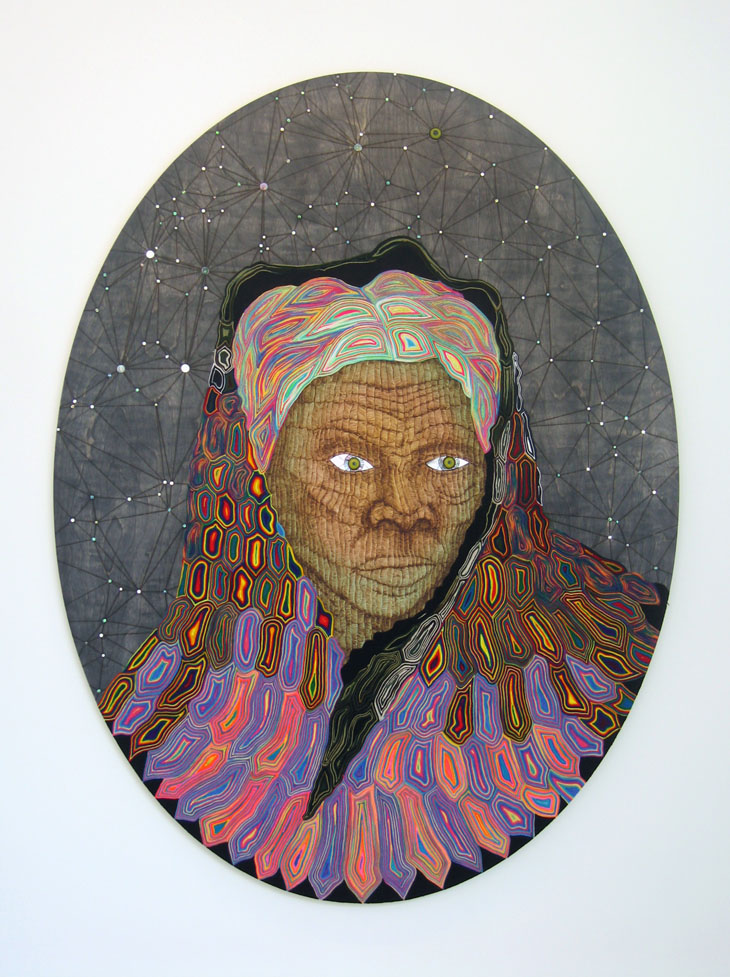
Matthew Day Jackson, "Harriet (Last Portrait)," 2006. Woodburned drawing, yarn, aniline dye, mother of pearl, abalone and black panther eyes on wood panel, 243.8 x 182.9 cm.
Carol Vogel of The New York Times wrote last month that, “Optimism has returned to the multibillion-dollar art market.” She was keen on a 1932 Picasso painting, Nu au Plateau de Sculpteur (Nude, Green Leaves, and Bust), and mentioned she’d be surprised if it wasn’t a record-breaking sale. Eight days later on Tuesday, May 4, a painting that Picasso made in a single day grabbed $106.5 million, making it the most expensive work of art ever sold at auction. The sale trumped the previous record of $104.3 million paid for Giacometti’s Walking Man I in February of this year, making for back-to-back record sales in the first two quarters of 2010. Even with Sotheby’s posting a narrower-than-expected quarterly loss ($2.2 million compared to last year’s loss of $34.5 million, according to Reuters), these auction sales make a real statement about the comeback of the market.
The real optimism, however, which is arguably more reliable than any wavering value cast by the market, is in Vogel’s portrayal of Matthew Day Jackson as the unsung hero of this year’s blue chip auctions. The artist drew $928,330 for a painting estimated to garner just less than $62,000 at a February auction at Christie’s in London, an incredible feat by any estimation. If any artist were to represent the future possibilities of the market, how deeply appropriate that it be Jackson, an artist whose very work seeks out and explores the potential of mankind.
A 2006 painting by the artist, Harriet (Last Portrait), to be auctioned on Wednesday, May 12, at Sotheby’s in New York, is already estimated at $300,000 to $400,000, and could very well break a million if the current circumstances continue to play out. Vogel’s description includes characterizations of Jackson as an “it” artist, and while I believe that the attention is more than well-deserved, exorbitant overnight rises in the prices of work probably create more questions than they do answers. One independent dealer I spoke with thinks it could create an illusion of value, potentially causing collectors to start flipping works.
“It takes all the reasonable planning and normal thought process, and chucks it out the window,” Bill Arning says of the near-million-dollar figure for Jackson. Arning, who is the director of the Contemporary Arts Museum, Houston, was the curator of Matthew Day Jackson: The Immeasurable Distance, which debuted at the MIT List Visual Arts Center in May 2009.
“This isn’t bad news for Matt, but it’s not all pluses,” Arning says. “Speculators—and we have to assume there are speculators—might decide this is a really good time to flip work because of the buzz… Matt is just too good an artist to let the whims of the auction market dictate the way his career goes.”
The irony is that Jackson’s painting, which depicts an unwavering Harriet Tubman in a cloak of brightly colored patterns against a backdrop of interconnected stars, can be understood as a portrait of human potential, while Jackson’s future represents a similar promise in a market poised to bounce back swiftly. Is it too early to cast Jackson as the helmsman of the new blue chip? Can we expect to see million dollar auction prices for him moving forward, or is this a temporary spike? What’s certain is that Jackson’s work is compelling enough to present the questions in the first place.